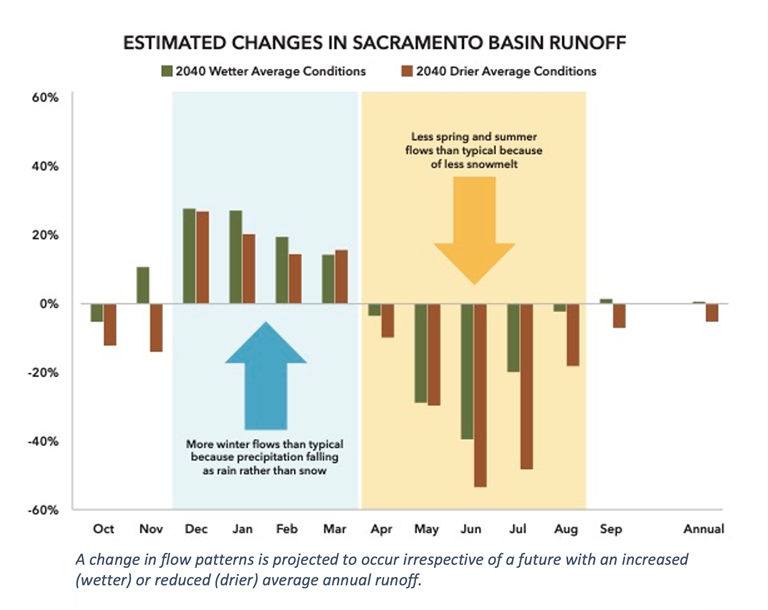How Will the Delta Conveyance Project Help Adapt to Climate Change?
Chart showing estimated changes in Sacramento Basin runoff.
The proposed Delta Conveyance Project would help ensure water supply reliability for the State Water Project in light of projected future changes in precipitation and seasonal flow patterns due to climate change.
Global climate models forecast a range of future scenarios, which show a variety of projected changes in annual runoff in the Central Valley (from -32% to +47%).
These climate models project:
- More precipitation will fall as rain instead of snow in the winter months
- More extreme climate events such as extreme drought and flood cycles
- Flashier storms, meaning pockets of intense precipitation scattered within dry stretches
These climate changes will directly affect water management in California. Existing water management facilities were designed to capture water in upstream reservoirs and in the Delta based on historic climate patterns. However, these climate patterns are changing.
Historically, winter precipitation came in the form of snow in the mountains and rain in the valley. The snowpack in the mountains has functioned as additional storage, delaying water from flowing into downstream reservoirs and into the Delta until late spring when it began to melt. This pattern of accumulating snowpack followed by slower snowmelt and more stable streamflow is the basis for historical water and flood management.
If climate change causes more precipitation to fall as rain instead of snow, the majority of the flow into reservoirs and the Delta is expected to occur in the winter months. This increased flow in the winter months cannot be captured to the historic extent in our upstream reservoirs or at the existing facilities in the south Delta.
State Water Project facilities are limited in their ability to store more water during the winter as our reservoirs have multiple purposes, including flood protection. A portion of space in reservoirs must be reserved to capture high flows to avoid flood events. The amount of this reserved storage capacity decreases starting April 1 when the chances of a major flood event decrease.
If climate change causes more precipitation to fall as rain in the winter months, reservoirs would not be able to capture as much water as they currently do when the runoff is spread out over both winter and spring. As flood protection space would still need to be reserved, water managers will be limited in their ability to store water from large, flashy winter rainstorms for later release.
In addition to not being able to store increased winter flows, water managers will also be limited in what can be captured in the Delta by physical and regulatory capacity limitations on existing State Water Project facilities located in the south Delta. The Delta Conveyance Project could help resolve this concern.
The proposed intakes for the Delta Conveyance Project would be in the north Delta and would not have the potential to affect fish in the same way as current diversions in the south Delta. The Delta Conveyance Project also proposes state-of-the-art fish screens and a set of operational criteria to avoid potentially significant effects to fish and water quality.
These criteria are different from those that apply in the south Delta because of the different diversion locations. The Delta Conveyance Project would add capacity to safely divert in the winter during high flow conditions while meeting water quality and sensitive species requirements. This increased diversion capability in the winter months is critical to capture projected increased winter flows caused by climate change.
Climate change is also expected to increase short-duration flashy winter rainstorms, resulting in short periods of high flows in the Delta. This could occur even during drought conditions, such as the events experienced in 2015 and 2021. Existing physical and regulatory constraints on the facilities in the south Delta limit our ability to capture this precious water supply when available. Thus, the Delta Conveyance Project would be especially valuable for providing operational flexibility and allow adaptation to the changing runoff patterns by capturing increased winter flows into the Delta, and high flows from flashy storm events in extended dry periods.
The Delta Conveyance Project would add new diversions in the north Delta to address these effects of climate change on Delta-conveyed water supplies. The State Water Project, with the proposed Delta Conveyance Project, would efficiently capture, move and store water during storm events and help ensure water supply reliability for 27 million Californians. In fact, if the proposed project had been operational during the storm events at the end of 2021, the State Water Project could have captured about 236,000 acre-feet of water, enough water for over 2.5 million people, or nearly 850,000 households, for a full year.
As climate change places strain our water resources, the state is taking proactive measures to respond to this challenge. Governor Gavin Newsom recently released “California’s Water Supply Strategy: Adapting to a Hotter, Drier Future,” which describes recent science indicating that California is moving towards drier future conditions and outlines a strategy to address these changes. The Delta Conveyance Project would be a critical part of this strategy as it would help capture, move, and store water when it is available. The Delta Conveyance Project would help address the shift in precipitation patterns regardless of the overall quantity of precipitation in the future.
Visit DWR’s webpage to learn more about the Delta Conveyance Project.
Click here to watch an animation on State Water Project climate change vulnerabilities.
